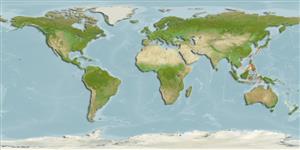Классификация / Names
народные названия | синонимы | Catalog of Fishes(род, виды) | ITIS | CoL | WoRMS | Cloffa
Environment: milieu / climate zone / depth range / distribution range
экология
морской батипелагический; пределы глубины 622 - 1412 m (Ref. 36330). Deep-water
Western Central Pacific: Sulu Sea.
Size / Вес / Возраст
Maturity: Lm ? range ? - ? cm
Max length : 23.4 cm SL самец/пол неопределен; (Ref. 36330)
Краткое описание
определительные ключи | морфология | морфометрия
членистые (мягкие) лучи спинного плавника (общее число) : 17 - 21; членистые (мягкие) лучи анального плавника: 14 - 18. Body shallow, maximum depth reaching 20%SL. Caudal peduncle relatively long (usually >18%SL). Vertical fin bases against each other. Head not very deep, moderately wide (postorbital width 11-12.5%SL). Snout very short but not blunt; its length 1.5-2.3 times smaller than orbit diameter; olfactory bulbs relatively large; ethymoid in olfactory bulb region relatively narrow. Eyes very large; orbit > 30% HL; no aggregations of light connective tissue in the orbit area around the eyeball; interorbital gap very narrow and < half the orbit diameter. Lacrimal not deep, significantly smaller than lens diameter, slightly overlapping maxillare. Seismosensory canals on head not extended, their pores not enlarged. No separate suprapreoperculum at the upper end of the praeoperculum; preopercular canal connects to the postorbital canal by means of a skin tube. Upper edge of upper jaw overlaps with the vertical of the rear edge of the lens, it may reach the vertical of the back edge of the orbit in large specimens. Supramaxilla 2; front one relatively long; its length equal or shorter than upper outgrowth of the posterior one. Photophores present on the head: a row of 4-5 infraorbitalias; 1 behind back edge of the orbit at its middle level; 5 on both sides along the lower jaw seismosensory canals; 2-4 along the upper 3 rays of the gill membrane; 1 each on the operculum, interoperculum, and between orbit and olfactory capsule. Photophores on body, situated above and below the lateral line, the size increases in the vertical direction that the largest ones cover the lower profile of the body; in front of the vertical fins; 3 rows in the caudal region; several irregular rows of small ones on the gill membranes. Pyloric caeca < 10 (Ref. 36330).
Life cycle and mating behavior
Maturities | размножение | Spawnings | Egg(s) | Fecundities | личинки
Sazonov, Y.I., 1999. A new species of the genus Rouleina (Argentiniformes, Alepocephalidae) from the Philippine Archipelago Seas and a redescription of R. livida and R. nuda. J. Ichthyol. 39(7):479-487. (Ref. 36330)
Статус Красного Списка МСОП (Ref. 130435)
Угроза для людей
Harmless
Использование человеком
дополнительная информация
инструменты
Специальные отчеты
Скачать в формате XML
ресурсы в Интернет
Estimates based on models
Preferred temperature (Ref.
123201): 5.4 - 10.1, mean 6.1 °C (based on 113 cells).
Phylogenetic diversity index (Ref.
82804): PD
50 = 0.5010 [Uniqueness, from 0.5 = low to 2.0 = high].
Bayesian length-weight: a=0.01000 (0.00244 - 0.04107), b=3.04 (2.81 - 3.27), in cm total length, based on all LWR estimates for this body shape (Ref.
93245).
Trophic level (Ref.
69278): 3.5 ±0.5 se; based on size and trophs of closest relatives
устойчивость к внешним воздействиям (Ref.
120179): средний (среднего размера), минимальное время удвоения популяции 1.4-4.4 года (Preliminary K or Fecundity.).
Fishing Vulnerability (Ref.
59153): Low vulnerability (19 of 100).
